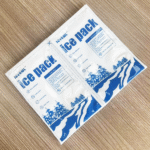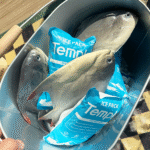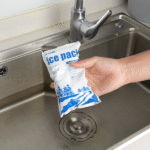Trockeneis wird in der Kühlkettenindustrie seit langem verwendet, um Produkte während des Transports auf der richtigen Temperatur zu halten. Egal, ob Sie versandt Essen, Medikamente, oder Biologische Proben, Trockeneis bietet eine zuverlässige Möglichkeit, die Unversehrtheit temperaturempfindlicher Waren zu bewahren. In diesem Artikel, Wir untersuchen die Vorteile und Best Practices der Verwendung Trockeneis zum Verpacken.

Dieser Artikel behandelt:
-
Warum ist Trockeneis für die Verpackung temperaturempfindlicher Güter unerlässlich??
-
Wie funktioniert Trockeneis in Verpackungen für den Versand??
-
Best Practices für die Verwendung von Trockeneis zur Aufrechterhaltung optimaler Temperaturen.
-
Gängige Branchen und Produkte, die von Trockeneisverpackungen profitieren.
Warum ist Trockeneis für die Verpackung temperaturempfindlicher Güter unerlässlich??
Trockeneis, verfestigt Kohlendioxid, ist ein leistungsstarkes Kühlmittel, das die Gefriertemperaturen viel länger aufrechterhält als herkömmliches Eis. Es sublimiert direkt in Gas, ohne dass Flüssigkeit zurückbleibt, was verhindert Wasserschäden in verpackter Ware. Für Artikel, die gleichmäßig kalte Temperaturen erfordern, wie zum Beispiel Arzneimittel, frisches Essen, Und Chemikalien, Trockeneis ist eine wirksame Wahl.
Trockeneis-Angebote ständige Kühlung über längere Zeiträume, Stellen Sie sicher, dass Ihre Waren bei optimaler Temperatur geliefert werden. Deshalb ist es ideal für Fernversand oder Lieferungen, die mehrere Tage dauern.
Wie Trockeneis in der Verpackung funktioniert
Trockeneis absorbiert beim Sublimieren Wärme, Dies führt zu einem Temperaturabfall um die Waren herum, mit denen es verpackt ist. Bei Verwendung als Verpackung, es hilft bei der Aufrechterhaltung eines Umgebung unter Null für Gegenstände, die während des Transports eingefroren oder gekühlt werden müssen. Trockeneisverpackungen werden häufig für Sendungen verwendet, die irgendwohin transportiert werden sollen 24 Zu 72 Std..
Best Practices für die Verwendung von Trockeneis in Verpackungen
Bei Verwendung von Trockeneis zum Verpacken, Um die Sicherheit und Effektivität Ihrer Sendungen zu gewährleisten, müssen mehrere Faktoren berücksichtigt werden:
1. Richtige Menge Trockeneis
Die Menge an benötigtem Trockeneis hängt von der Größe der Packung ab, Die Versanddauer, und die externe Temperatur. Typischerweise, 5 Zu 10 Pfund Trockeneis wird pro benötigt 24 Stunden des Versands. Es empfiehlt sich immer, die benötigte Menge zu überschätzen, um Temperaturschwankungen während des Transports zu vermeiden.
2. Richtige Isolierung
Zur Verlängerung der Kühldauer, Es ist wichtig, angemessen zu verwenden Isoliermaterialien. Styroporboxen, Isoliertaschen, Und Thermofutter verhindern, dass das Trockeneis zu schnell sublimiert, sodass es länger hält.
3. Paketlüftung
Trockeneis benötigt Platz sicher sublimieren, also ist es wichtig lüften die Verpackung ordnungsgemäß. Ein verschlossener Behälter ohne Belüftung könnte zu a führen Bildung von Kohlendioxidgas, Dies kann ein Sicherheitsrisiko darstellen. Stellen Sie sicher, dass die Verpackung über kleine Belüftungslöcher verfügt, damit das Gas entweichen kann, ohne die Kühleffizienz zu beeinträchtigen.
| Verpackungsfaktor | Trockeneisverpackung | Traditionelle Eisbeutel |
|---|---|---|
| Kühldauer | 24 Zu 72 Std. | 12 Zu 24 Std. |
| Gefahr von Undichtigkeiten | Keiner | Hoch aufgrund von Wasser |
| Temperaturbereich | Temperaturen der Unter Null | Im Allgemeinen über dem Gefrierpunkt |
| Ideal für | Pharmazeutika, Essen, Chemikalien | Kurzfristige Kühlung |
Gängige Branchen und Produkte, die von Trockeneisverpackungen profitieren
Mehrere Branchen verlassen sich beim Verpacken auf Trockeneis, um temperaturempfindliche Produkte während des Versands zu schützen. Hier ein paar Beispiele:
-
Lebensmittelindustrie: Gefrorenes Essen, Meeresfrüchte, und Eis erfordern Temperaturen darunter -18°C zur Konservierung. Trockeneis sorgt für eine länger anhaltende kalte Umgebung als herkömmliche Eisbeutel.
-
Pharmaindustrie: Drogen, Impfungen, und Biologika müssen bei bestimmten niedrigen Temperaturen aufbewahrt werden. Für die Aufbewahrung eignet sich Trockeneis hervorragend gefroren Während des Transits.
-
Chemische Industrie: Einige Chemikalien müssen bei niedrigen Temperaturen transportiert werden, um ihre Haltbarkeit zu gewährleisten Stabilität Und Wirksamkeit. Trockeneis sorgt dafür, dass sie im richtigen Temperaturbereich bleiben.
Warum Trockeneis für diese Produkte bevorzugt wird
-
Tiefkühlkost: Trockeneis hält Lebensmittel länger gefroren, verhindern Qualitätsverschlechterung und sorgt für Frische bei der Ankunft.
-
Impfungen: Viele Impfstoffe, wie zum Beispiel die für COVID 19, müssen gelagert und transportiert werden Ultra-niedrige Temperaturen. Trockeneisverpackungen tragen dazu bei, diese Bedingungen aufrechtzuerhalten.
-
Chemikalien: Bestimmte Chemikalien erfordern präzise Temperaturregelung um Veränderungen zu verhindern chemische Struktur, was mit Trockeneis erreicht werden kann.
Sicherheitsüberlegungen zur Verwendung von Trockeneis in Verpackungen
Während Trockeneis für die Verwendung in Verpackungen unbedenklich ist, es gibt einige Sicherheitsvorkehrungen das muss genommen werden:
-
Handhabung: Immer tragen Isolierte Handschuhe Bei der Behandlung von Trockeneis, um Erfrierungen vorzubeugen.
-
Belüftung: Stellen Sie sicher, dass das Paket ist belüftet richtig, um die Sublimation von Trockeneis zu ermöglichen.
-
Versandvorschriften: Trockeneis wird als klassifiziert als Gefahrgut und muss sein entsprechend gekennzeichnet bei Versand per Luft- oder Landtransport.
Beispiel für reale Welt: Ein Logistikunternehmen nutzte Trockeneisverpackungen für den Versand biologischer Proben klinische Studie. Die Verpackung hielt die Temperaturen darunter -18°C für 72 Std., Sicherstellen Integrität der Proben beim Transport und Minimierung der mit Temperaturschwankungen verbundenen Risiken.
2025 Trends bei Trockeneisverpackung
Da die Nachfrage nach temperaturempfindlichen Sendungen wächst, ebenso die Verwendung von Trockeneis zum Verpacken. Hier sind einige aktuelle Entwicklungen:
-
Nachhaltige Trockeneisproduktion: Es gibt eine wachsende Betonung auf nachhaltig Trockeneisproduktion. Unternehmen konzentrieren sich auf CO2-neutrale Prozesse Trockeneis herzustellen, Reduzierung der Umweltauswirkungen.
-
Intelligente Verpackungslösungen: Neu intelligente Verpackungen Mit Temperatursensoren und Echtzeitüberwachung verbessert sich die Genauigkeit Und Effizienz von Trockeneistransporten.
-
Umweltfreundliche Isolierung: Mit zunehmendem Bewusstsein für Umweltthemen, Unternehmen entscheiden sich für umweltfreundliche Dämmstoffe die sich gut mit Trockeneis kombinieren lassen und eine insgesamt nachhaltige Versandlösung ergeben.
Wichtige Trends in der Kühlkettenbranche
-
Verpackungsinnovation: Unternehmen stellen vor fortschrittliche Isolationstechnologien um die Lebensdauer von Trockeneis zu verlängern und Optimieren Sie die Temperaturregelung.
-
KI und Automatisierung: Die Annahme von Ai in der Logistik hilft bei der Prognose ideale Menge Trockeneisbedarf je nach äußeren Bedingungen.
Häufig gestellte Fragen {#FAQ}
Wie lange ist Trockeneis in einer Versandverpackung haltbar??
Trockeneis kann dazwischen dauern 24 Zu 72 Std., Abhängig von der verwendeten Menge und der Isolierung der Verpackung.
Ist Trockeneis versandsicher??
Ja, Trockeneis ist sicher, wenn es richtig gehandhabt und in gut belüfteten Verpackungen verwendet wird. Jedoch, immer folgen Versandvorschriften.
Wie lagere ich Trockeneis vor der Verwendung??
Trockeneis sollte darin gelagert werden belüftete Bereiche, weg von Wärmequellen. Es sollte niemals in einem vollständig verschlossenen Behälter aufbewahrt werden.
Zusammenfassung und Empfehlungen
Trockeneis ist a sichere und wirksame Lösung zur Aufrechterhaltung kalter Temperaturen während des Transports. Es ist besonders vorteilhaft für Branchen wie Arzneimittel Und Essen, wo die Aufrechterhaltung der richtigen Temperatur entscheidend ist. Durch Befolgen der Best Practices für Verpackung und Sicherheit, Sie können sicherstellen, dass Ihre Produkte in einwandfreiem Zustand ankommen.
Nächste Schritte: Erwägen Sie eine Integration Trockeneisverpackung in Ihre Versandprozesse, besonders für temperaturempfindliche Güter. Für optimale Ergebnisse, konsultieren Sie a Experte für Kühlkettenlogistik für Beratung zu Verpackungslösungen.
Über Tempk
Bei Tempk, Wir sind auf die Bereitstellung hochwertiger Kühlkettenlösungen spezialisiert, inklusive Trockeneisverpackung für den Langzeitversand. Unsere Dienstleistungen helfen Unternehmen dabei, sicherzustellen, dass ihre Produkte während des gesamten Transports sicher und kalt bleiben.
Kontaktieren Sie uns Weitere Informationen zu unseren Trockeneis-Verpackungsdienstleistungen erhalten Sie noch heute.























